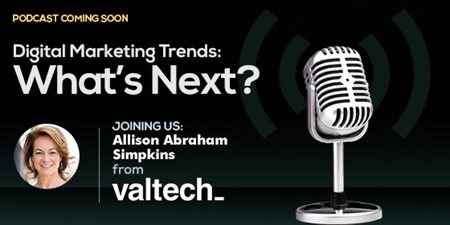November Podcast Will Focus on the Future of Digital Marketing
By Laura Myers
November 16, 2018
Allison Abraham Simpkins, Digital Marketing, Facebook, Hootsuite, Influencer Marketing, Instagram, Podcast, Snapchat, social media, Valtech
I have to admit, when I started researching the top digital marketing predictions for 2019, I was seeing  some familiar characters commonly brought up in trend conversations for other areas like eCommerce, web content management, etc. All relevant and all useful, but the same nonetheless. The proliferation of voice technology, the effectiveness of AI and machine learning, manipulating realities with AR and VR and so on are all valuable in customer engagement but how should they be deployed in a marketing specific capacity? I know it can be splitting hairs when looking at customer engagement along the consumer journey vs digital marketing but for the sake of conversation, I decided to split them.
some familiar characters commonly brought up in trend conversations for other areas like eCommerce, web content management, etc. All relevant and all useful, but the same nonetheless. The proliferation of voice technology, the effectiveness of AI and machine learning, manipulating realities with AR and VR and so on are all valuable in customer engagement but how should they be deployed in a marketing specific capacity? I know it can be splitting hairs when looking at customer engagement along the consumer journey vs digital marketing but for the sake of conversation, I decided to split them.
For our November podcast, Gabriella Pirrone and I are going to dive into the top three technology trends that will be game changing in 2019 but, in a strictly digital marketing capacity. We’re going to cover voice, video and social media.
Also, we are going to have a guest for the podcast! Allison Abraham Simpkins, SVP of North America for Valtech will be featured in the conversation discussing the most effective digital marketing strategies she has encountered lately and which trend she thinks will disrupt digital marketing the most in the next few years. As a follow-up to the recent case study we shared featuring Valtech, Sitecore and L’Oréal, she will share the biggest challenges for digital marketers in the beauty industry and how partner agencies can work effectively with the large digital teams behind global brands like L’Oréal.
Digital Marketing Trend #1: Voice Technology
The voice wars are on. Amazon Alexa has commerce on its side, Siri lives in most of our pockets and Google Home has its search capabilities locked in. But at any rate, regardless of their better fit for each individual, the jury is out on which is better for marketers. Until the verdict is in, it’s advisable for marketers to look at both Alexa skills and Google Home apps for their voice strategy when it comes to devices. The advantages of voice are many but perhaps its greatest trick is its ease of interaction and ability to engage. For marketers, this means you can reach customers while they are busy doing other things and the amount of attention needed isn’t as high as with social media, content etc.
In a recent CMS-Connected interview with Preston So, Director of Research and Innovation at Acquia Labs, he goes into the ways in which marketers can start to leverage voice technology: "As AI and voice assistants continue to grow in popularity, brands can ensure their strategy is optimized for this new technology by getting to know their buyers, continuing to offer immersive experiences, and creating realistic goals. Before preparing a voice-assisted search strategy, marketers must look at consumers and determine if they even have a presence on voice-enabled devices. We also suggest marketers begin to experiment with this technology to determine how it performs for them. By using A/B testing, marketers can determine if messages are resonating better via voice, mobile app or browser. Once marketers examine all of their options, they can make an informed decision on how voice-enabled tech will work for their goals."
The biggest takeaway with voice is to know it’s not a distant goal, there’s no putting a pin in it to evaluate in Q2 of 2020, the time to develop a marketing strategy using voice is now so by the time the rest of the brands in your market catch up, you’ve had a year of insight fed into your strategy to improve on a plan they’re all just starting. Also, as Preston says here, you’ll be some of the first brands to meet more customers where they are: “The brands and merchants who take the lead in voice-enabled shopping will have an advantage by allowing consumers to explore shopping channels outside of browser and mobile apps. Consumers shop on a plethora of devices already, and this is only going to increase in the years to come."
Digital Marketing Trend #2: Video Marketing
The use of video in marketing is still a little underrated and it absolutely shouldn’t be. Can you imagine if as a marketer you know 92% of those who read your content would share it? They won’t. But if the message of your content were a video they would. Or just think if the content on your landing page could increase your conversion rate by 80%. That’s possible but not proven but do you know what will? You guessed it, video!
In a recent conversation I had with Tyler Lessard, VP of Marketing at Vidyard he explains a bit of why video is taking hold in digital marketing: “In short, video is in high demand and is easier than ever to supply. As a result, video in marketing has gone from a tool for Brand and Social Media to being an integral part of websites, content marketing, thought leadership, customer stories and more.”
The misconception behind why more aren’t adopting video I think lies in the fact that marketing teams think video is too hard. It means equipment and production, it means a quiet space, it means long hours writing scripts and recording takes until you get one that’s just right. All of this is a reality with video but it doesn’t have to be where you start. A camera and a microphone are built into that little phone in your pocket and depending on your brand, the more genuine and authentic the content the better.
None of it takes away from the fact that with any marketing content, you need to ensure ROI. Thankfully, as Tyler mentions below, there are plenty of video platforms out there to help with that: “One of things we’ve focused on at Vidyard is providing a suite of video enablement tools that not only help businesses expand their use of video across teams and use-cases, but help them track which content is impacting lead generation, opportunity close rates, customer service efficiency and even employee engagement. Reporting dashboards within Salesforce are our latest extensions to this, giving marketing and sales team direct visibility into how different videos are influencing pipeline and revenue across their business. These insights are helping businesses understand what type of content is really working to move the needle on key business metrics.”
Digital Marketing Trend #3: Social Media
It’s been a tough year for social media especially in reference to digital marketing. Instagram has enacted some algorithm changes that really threw a wrench in the mix for brands who rely heavily on it for content exposure. Facebook’s missteps with the use of personal data and ad targeting caused a huge rift in the trust consumers have in the platform and Snapchat, well, they’ve just had an overall rough year.
One of the biggest hits however came from Unilever taking the influencer marketing trend to task and quite publicly announced that because of their unfortunate experience with inflated reach and wasted ad dollars, they would no longer work with influencers who purchased followers. While some may say this challenge might not phase the global influencer marketing industry set to be worth an estimated $10 billion by 2020, it has ignited a conversation amongst many established brands, creatives and general marketing thought-leaders in standing behind Unilever to say they too have been feeling the rapid ascent of influencer marketing and enticing projected revenues sounded a little too good to be true.
All is not lost though. Major social media tycoon Hootsuite continues to make moves like their partnership announcement with Adobe to empower the common marketer even further with integrated capabilities baked right into their platform and, continuing the trend we have seen of encouraging and quantifying the value of creative content.
Pinterest has also found their sweet spot in the social media space with a massive jump in their advertising potential this last year. The virtual pin board of ideas has seen an effective monetization of their user base of over 250 million with their advertising sales jumping 58% to $473 million. This is great news for digital marketers who want to add another tenant to their social media strategy outside of the obvious players Instagram, Facebook and Snapchat.
As for social media strategy, we’ll save that for the podcast, so make sure you tune in at the end of November to hear all about why the above digital marketing trends need to be on your radar in 2019!

Laura Myers
A digital business, marketing and social media enthusiast, Laura thrives on asking unique, insightful questions to ignite conversation. At an event or remotely, she enjoys any opportunity to connect with like-minded people in the industry.